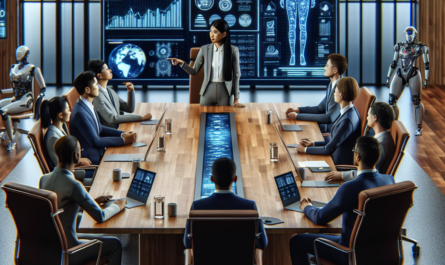As technology continues to advance at an unprecedented rate, artificial intelligence (AI) is becoming increasingly integral in a myriad of fields, notably User Experience (UX) Design. The intersection of AI and UX Design is a dynamic and continually evolving nexus that holds immense potential for transforming how users interact with digital interfaces. This exploration will delve into the foundational concepts of AI as they relate to UX Design, illuminate real-world applications across diverse sectors, and dissect the inherent strengths and drawbacks that accompany the fusion of AI and UX Design. Furthermore, the study will provide a glimpse into the exciting future trajectories that are poised to redefine the landscape of UX Design through AI applications.
Understanding AI in UX Design
Understanding Artificial Intelligence and User Experience Design
Artificial Intelligence, commonly known as AI, is a branch of computer science that is all about creating machines or software that display elements of human intelligence. This includes tasks that normally require human intuition such as interpreting natural language, recognizing patterns, and problem-solving. The ultimate goal of AI is to develop machines that can perform tasks that would normally require human intelligence.
User Experience (UX) design, on the other hand, is about creating satisfying and pleasant interactions between consumers and digital products such as websites, software, and mobile apps. The fundamental goal of UX design is to elevate the user’s experience, making it intuitive and enjoyable, leading to increased customer satisfaction and loyalty.
Intersection of AI and UX Design
Where AI and UX design intersect is in the creation of products that not only satisfy customer needs but are intelligent and predictive. With AI, UX designers can create interfaces that learn from interactions with the user and can predict their needs before they even ask. This level of personalized service can significantly enhance user satisfaction.
For instance, think about giant e-commerce platforms that use AI to personalize user experiences. These platforms use AI algorithms to analyze your search patterns and purchase history, predict what you may want to buy next, and present these options at the right time. This anticipatory service greatly enhances the overall user experience, making shopping on such platforms a delight.
Incorporating AI in UX Design
Utilizing AI in UX design is all about creating interfaces that are adaptive, intuitive, and engaging. It involves the use of predictive analysis, Natural Language Processing (NLP), machine learning, and other AI-related techniques to deliver next-level user experiences.
Consider a music streaming application that uses AI to understand your music preferences based on your listening history. It can predict the kind of music you might want to listen to at different times of the day and provide curated playlists. This creates a sense of personalization and understanding for the user, greatly improving their interaction with the application.
Another example is the use of chatbots in website interfaces. Chatbots use NLP and machine learning algorithms to engage with website visitors, providing instant responses to queries and aiding in navigation.
Foundational Elements for Using AI in UX Design
Some of the basic foundations for incorporating AI within UX Design include:
- Understanding the technology: UX designers must understand the basic workings of AI and machine learning. This does not necessarily mean learning how to code, but understanding the capabilities and limitations of AI can guide the design process.
- Focusing on the user: Regardless of the technology involved, the user remains the central focus of UX design. The AI capabilities should be geared towards improving and personalizing the user experience, not just for the sake of technology.
- Iterative testing: Due to the unprecedented nature of AI, frequent testing and adjustment are important components of the design process. AI functionality should be constantly tested and tweaked based on user feedback.
AI and UX might seem like separate entities, but their potential to amplify one another is genuinely transformative. Modern UX designers are now challenged with harnessing the capabilities AI offers and integrating them with the fundamentals of user-centric design. By doing this, they can advance and optimize the experiences within the digital ecosystem.

Real-World Application of AI in UX Design
Netflix: An Illustration of AI and UX Synergy
A great example illustrating this fusion of AI and UX design is Netflix. Aware that the abundance of choices can overwhelm users, Netflix deployed an AI-driven recommendation system to refine user experience. It uses machine learning algorithms that scrutinize and track users’ habits, preferences, and viewing history, to put together a bespoke content selection. This tactic not only boosts user interaction but also results in longer periods spent on the platform. By integrating AI to streamline the user experience, Netflix has secured a significant advantage in the fiercely competitive entertainment market.
AI in Google’s UX Design
Google takes AI incorporation into UX design to another level. Its auto-complete feature uses predictive AI to suggest results when users are searching. Additionally, the Google Assistant utilizes natural language processing, an AI subset, to understand user’s voice commands and bring a conversational aspect to the UX design. The AI also learns from previous interactions to fine-tune the commands and ensure the accuracy improves over time.
AI in Spotify’s UX Design
Spotify brilliantly incorporates AI in its UX design to personalize the user’s listening experience. AI’s machine learning algorithms meticulously study users’ listening habits, genre preferences, and search history to develop personalized playlists, such as “Discover Weekly” and “Daily Mix”. This use of AI not only improves user engagement but also encourages users to explore new music and artists.
AI in Amazon’s UX Design
Incorporating AI into UX design, Amazon utilizes its robust recommendation engine to improve the user experience. Amazon’s machine learning algorithms analyze the user’s browsing history, purchased items, and clicked links to generate personalized product suggestions. Presumably, these suggestions will be highly relevant to the user and increase the likelihood of purchase. Additionally, Amazon’s AI-powered virtual assistant Alexa enhances the user experience by facilitating voice-based purchases, thereby offering a unique and effortless shopping experience.
AI in Airbnb’s UX Design
For Airbnb, AI has greatly improved the UX design by simplifying the price-setting process for hosts. Instead of researching local rental rates and making an educated guess, hosts can now use Airbnb’s AI model that recommends pricing based on a range of factors, including location, property type, time of year, and more. The AI model evolves over time, incorporating data from past transactions to refine its predictions. Enhancements like this not only simplify the platform for hosts but also encourage new hosts to join Airbnb.
Within various sectors, from entertainment and e-commerce to search engines and hospitality, AI has gradually become a game-changer in UX Design. The focus on tailored experiences, improved user-friendly designs, and thorough comprehension of users’ requirements has allowed AI to usher in a new era for UX design. As advancements in AI technology show no signs of slowing down, it is predicted that its role in UX design will grow significantly more consequential.

Advantages and Challenges of AI in UX
Understanding the Benefits of AI Integration in UX Design
An overture to the advantages of applying AI in UX design is its remarkable contribution towards enhancing efficiency. By harnessing the capabilities of AI in machine learning and data crunching, it can execute complex tasks that would otherwise demand extensive human effort, and that too in a mere fraction of the time. Some AI tools are even designed to identify patterns and insights from huge data sets, thereby empowering UX designers to make quick, empirically-backed decisions regarding design alterations and improvements.
Delving deeper into the advantages, AI’s strategy towards personalization emerges as a key benefit. Through comprehensive collection and analysis of user data, AI is able to offer customized experiences to each user. This level of personalization not only heightens user satisfaction and engagement, but also adds a sense of uniqueness to the UX, as it aligns more closely with their individual preferences and behaviors. To put it in perspective, AI can recommend products based on a user’s previous purchases or browsing patterns, thereby enriching the user’s engagement with the product or platform.
AI’s capability to automate repetitive tasks offers another significant boon in UX design. It relieves UX designers from time-consuming, monotonous tasks, allowing them to concentrate on more creative and critical aspects of design. By automating procedures like A/B testing, interaction scrutiny, and heat map creation, AI can effectively unburden UX teams, gifting them more time to strategize and innovate.
Challenges of Incorporating AI in UX Design
Despite these benefits, incorporating AI into UX design does not come without its challenges. One of the primary concerns is the issue of user privacy. With AI’s inherent deep-learning capabilities, it often requires access to large amounts of personal data to function effectively. But this need conflicts with growing public concerns over data privacy. Users are becoming more aware of how their data is used and the potential misuse by non-ethical actors. Thus, striking a balance between personalization and privacy is a significant challenge.
Further, incorporating AI into UX design necessitates a learning curve and constant upskilling. The field of AI is complex and continuously changing, with new developments, tools, techniques, and ethical considerations constantly emerging. For UX designers to effectively integrate AI, they must stay up-to-date and be willing to continuously learn and adapt to new information.
Lastly, regardless of how advanced AI becomes, it may never fully replace the human touch necessary for UX design. This is because AI still lacks the emotional intelligence, empathy, and human intuition required in UX design. Therefore, even with AI integration, the need for human designers to oversee and make critical decisions remains paramount.
There are numerous advantages to incorporating AI in UX design, such as the ability to perform tasks quickly, provide a personalized experience, and automate numerous processes. Yet, this approach is not without its challenges; privacy concerns and the necessity for ongoing learning and development stand out as considerable obstacles. Hence, it is essential for establishments and UX design teams to take a mindful approach when considering how and to what degree AI should be included in their processes.

Future perspectives: AI in UX Design
Future Prospects and Anticipated Improvements
The realm of UX design has already started to feel the impact of advances in artificial intelligence, altering traditional norms. It is anticipated that this technological shift will proceed to permanently transform the landscape, aiming for more intuitive and user-friendly interactions. AI has the potential to enhance predictions of user behavior, offer highly personalized recommendations, and excel the quality of user engagement.
Anticipate User Needs
One of the more pertinent predictions for AI in UX design is that it will continue to hone its ability to anticipate and adapt to user’s needs. AI systems, driven by machine learning algorithms, can collect and analyze vast amounts of user data to discern patterns of behavior, preferences, and habits. This information can be employed to design interfaces that are more responsive and tailor-made to provide solutions even before a user realizes they need them.Improved Accessibility
AI can and will continue to be used to improve the accessibility of digital platforms, making them more inclusive to users with varying abilities. Enhanced voice recognition capabilities, text-to-speech and speech-to-text transformations, smart captions, facial recognition, and other similar technologies will make platforms more accessible to all users.Enhanced Personalization
AI systems can increasingly collect, analyze and understand user data, allowing for a level of personalization that has never been achieved before. For UX/UI designers, this means creating designs that are more adaptable and capable of personalizing the user’s experience on an individual basis. This will inevitably lead to highly customized and personalized interfaces.Predictive Design
Predictive UX design would be facilitated by AI. By mining user data and leveraging machine learning, UX designers will be able to anticipate user behaviors and needs, allowing for predictive design elements that enhance user interactions. This kind of user-centric design will increase user engagement and improve conversion rates.Potential Advancements Influencing Future UX Design
Emerging technology trends are providing glimpses into the future where AI will play an increasingly influential role in UX design. In particular, augmented reality (AR) and virtual reality (VR) are predicted to increase in prominence. Through the employment of advanced AI solutions, AR and VR can provide fully immersive and interactive user experiences that transcend conventional screen-based interfaces.In addition, leveraging AI with the Internet of Things (IoT) can create smart environments that interact seamlessly with users
. Machine learning algorithms can keep learning and improving, enabling physical spaces to evolve with user behavior and preferences.Finally, advancements in Conversational AI (like chatbots or virtual assistants) are predicted to keep growing, creating opportunities for voice User Interface (UI) and natural language processing
. This will allow users to interact with digital interfaces in a natural and intuitive way.
As we navigate forward in the digital age, it is undeniable that AI will continue to play a pivotal role in shaping the terrain of UX Design. The breadth and complexity of AI’s applicability in UX lends itself to an array of personalized, efficient, and automated solutions, despite the attendant challenges. By examining past case studies and future predictions, a comprehensive picture of AI’s transformative power within UX Design emerges. The exploration, therefore, underscores the essence of adaptability and continuous learning in harnessing the full potential of AI in this exciting field. The age of AI in UX Design is not only upon us but is also continually evolving, set to redefine and enrich user experiences in ways yet to be fully imagined.
Writio: The AI Content Writer of Choice – Effortlessly create engaging website content and blog articles with Writio. This article was crafted by Writio’s AI prowess.




